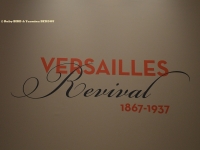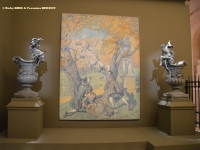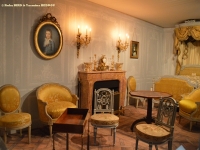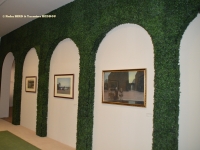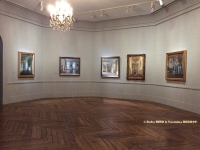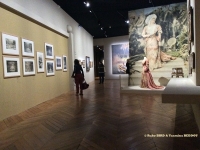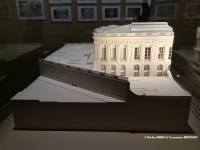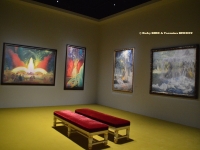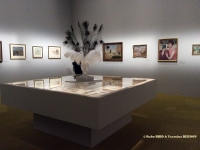Arts
VERSAILLES REVIVAL EXHIBITION 1867 - 1937
November 19, 2019 - March 15, 2020
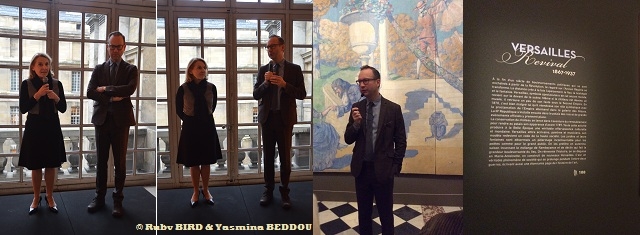
Catherine PEGARD & Laurent SALOME (Source: © Ruby BIRD & Yasmina BEDDOU)
USPA NEWS -
At the End of the 19th Century, the Palace of Versailles made a Spectacular Comeback. As it regained it Status as a National Symbol and was the Scene of Political Events, the Nostalgia surrounding its Former Splendour became a Source of Inspiration for Literature, the Arts and Fashion. The Prosperity of Versailles, the Poetry of its Gardens, the Ghosts of the "Sun King" and Marie-Antoinette became a Part of the Dreams of the Belle Époque, followed by the Roaring Twenties. This was also a Time when the Palace launched Major Restoration and Refurnishing Work, triggering Passionate Debates that have continued into the Present Day.
At the End of the 19th Century, the Palace of Versailles made a Spectacular Comeback. As it regained it Status as a National Symbol and was the Scene of Political Events, the Nostalgia surrounding its Former Splendour became a Source of Inspiration for Literature, the Arts and Fashion. The Prosperity of Versailles, the Poetry of its Gardens, the Ghosts of the "Sun King" and Marie-Antoinette became a Part of the Dreams of the Belle Époque, followed by the Roaring Twenties. This was also a Time when the Palace launched Major Restoration and Refurnishing Work, triggering Passionate Debates that have continued into the Present Day.
The Palace of Versailles was the Principal Royal Residence of France from 1682, under Louis XIV, until the start of the French Revolution in 1789, under Louis XVI. The Palace is now an Historical Monument and UNESCO World Heritage Site, notable especially for the Ceremonial Hall of Mirrors, the Jewel-Like Royal Opera, and the Royal Apartments; for the more Intimate Royal Residences, the Grand Trianon and Petit Trianon located within the Park; the small Rustic Hameau (Hamlet) created for Marie Antoinette; and the vast Gardens of Versailles with Fountains, Canals, and Geometric Flower Beds and Groves, laid out by André le Nôtre. The Palace was stripped of all its Furnishings after the French Revolution, but many Pieces have been returned and many of the Palace Rooms have been restored.
Louis XIV first visited the Château on a hunting trip in 1651 at the Age of Twelve, but returned only occasionally until his Marriage to Maria Theresa of Spain in 1660 and the Death of Cardinal Mazarin in 1661, after which he suddenly acquired a Passion for the site. He decided to rebuild, embellish and enlarge the Château and to transform it into a Setting for both rest and for elaborate entertainments on a Grand Scale... The King increasingly spent his Days in Versailles, and the Government, Court, and Courtiers, numbering six to seven thousand Persons, crowded into the Buildings.
Louis XIV died in 1715, and the young new King, Louis XV, just Five Years Old, and his Government were moved temporarily from Versailles to Paris under the Regency of Philippe II, Duke of Orléans. In 1722, when the King came of age, he moved his Residence and the Government back to Versailles, where it remained until the French Revolution in 1789. Louis XV remained Faithful to the Original Plan of his Great-Grandfather, and made few Changes to the Exteriors of Versailles.... Louis XVI was constrained by the worsening Financial Situation of the Kingdom from making Major Changes to the Palace, so that he primarily focused on Improvements to the Royal Apartments. Louis XVI gave Marie Antoinette the Petit Trianon in 1774. The Queen made Extensive Changes to the Interior, and added a Theater, the Théâtre de la Reine. She also totally transformed the Arboretum planted during the Reign of Louis XV into what became known as the Hameau de la Reine.
In 1783, the Palace was the Site of the Signing of Three Treaties of the Peace of Paris (1783), in which the United Kingdom recognized the Independence of the United States.... When Napoleon Bonaparte became Emperor of the French in 1804, he considered making Versailles his Residence, but abandoned the Idea because of the Cost of the Renovation. Prior to his Marriage with Marie-Louise in 1810, he had the Grand Trianon restored and refurnished as a Springtime Residence for himself and his Family, in the Style of Furnishing that it is seen Today.
The French Revolution of 1830 brought a New Monarch, Louis-Philippe to Power, and a New Ambition for Versailles. He did not reside at Versailles, but began the Creation of the Museum of the History of France, dedicated to "All The Glories of France", located in the South Wing of the Palace, which had been used to House some Members of the Royal Family. The Museum was begun in 1833 and inaugurated on 30 June 1837. Its most Famous Room is the Galerie des Batailles (Hall of Battles), which lies on most of the Length of the Second Floor.
The end of the 19th and the early 20th Century saw the Beginning of Restoration Efforts at the Palace, first led by Pierre de Nolhac, Poet and Scholar and the First Conservator, who began his work in 1892. The Conservation and Restoration was interrupted by Two World Wars, but has continued until the Present Day. The Palace briefly returned to the World Stage in June, 1919, when the Treaty of Versailles, formally ending the First World War, was signed in the Hall of Mirrors. Between 1925 and 1928, the American Philanthropist and Multi-Millionaire John D. Rockefeller gave $2,166,000, the equivalent of about Thirty Million Dollars today, to restore and refurnish the Palace... More Work took place after World War II, with the Restoration of the Royal Opera of Versailles. The Theater was reopened in 1957, in the Presence of Queen Elizabeth II of the United Kingdom.
***** From 19 November 2019 to 15 March 2020, the Africa and Crimea Rooms will play host to the “Versailles Revival“ Exhibition, looking at how, between 1867 and 1937, the Palace ignited Passions for Versailles in its Ancien Régime Version as it Underwent an Extensive Programme of Restoration and Refurbishment....
One Hundred Years after the French Revolution, on the Eve of the “Belle Époque“, there emerged a Tremendous Buzz of Excitement, Nostalgia, Curiosity and Passion for the Versailles of the Ancien Régime. By way of almost 350 Artworks ““ many of them from Private and International Collections ““ along with Documents and Photographs, the “Versailles Revival“ Exhibition charts this remarkable moment in the History of Art, when Versailles took its place among the Great Literary, Pictorial and Musical Canons. Artists from all Corners of the World were drawn to this place, which inspired Imitations across the Globe. Versailles is also where the French Republic held its Assemblies and received Foreign Dignitaries. The Gardens were a Popular Location for Aristocratic Parties and Public Tourism, and the Wonderful Water Features maintained their Appeal throughout the 19th Century, becoming a real Crowd-Puller. And all of this while a major programme of Restoration and Refurbishment was underway at the Palace, which passed the Million-Visitor Mark back in 1937.
Though this New Passion first began to stir around the Time of the Second French Empire, what with the Empress Eugenie´s Devotion to Marie-Antoinette, it took until the end of the century for this Fascination to spread to the Artistic and Literary Domains. Marcel Proust rediscovered “Versailles, your renowned name, rusty and sweet, a royal cemetery of leaves, of vast expanses of water and marble“. The most diverse Painters drew inspiration from it, from the Russian Alexandre Benois to Georges Rouault, not forgetting Gaston La Touche, Lucien Lévy-Dhurmer and Henri Le Sidaner, as well as Photographers such as Eugène Atget, Edward Steichen and Man Ray. Cinema, too, from its earliest stages, became caught up in it.
The Furniture and Decorative Objects served as great Royal Exemplars. The Palace, too, served as the Model for Ludwig II of Bavaria, as well as for the Residences of Boni de Castellane and Alva Vanderbilt and even the SS France ocean liner of 1912, nicknamed “the Versailles of the Sea“. Incredible parties saw Trianon brought back to life. Sarah Bernhardt performed at the Palace during the Visit of Tsar Nicolas II, in 1896. A Society outside of its time sprang up around the Iconic Monument and included Fashionable Figures, such as Countess Greffulhe and Robert de Montesquiou; the Writers Marcel Proust and Henri de Régnier; Musicians Reynaldo Hahn and Gabriel Fauré; Painters Paul Helleu and Giovanni Boldini; and the intriguing Garden Designer, Achille Duchêne....
Source : Château De Versailles (Versailles Palace).
In presence of Madam Catherine PEGARD President of The Chateau of Versailles
Visit of the Exhibition with Laurent SALOME Director of the National Museum of Castles of Versailles & The Trianon
Ruby BIRD
http://www.portfolio.uspa24.com/
Yasmina BEDDOU
http://www.yasmina-beddou.uspa24.com/
In presence of Madam Catherine PEGARD President of The Chateau of Versailles
Visit of the Exhibition with Laurent SALOME Director of the National Museum of Castles of Versailles & The Trianon
Ruby BIRD
http://www.portfolio.uspa24.com/
Yasmina BEDDOU
http://www.yasmina-beddou.uspa24.com/
Ruby Bird Yasmina Beddou Chateau De Versailles Versailles Revival 1867 1937 Exhibition November 19 2019 March 15 2020 350 Works Documents And Photographs
Liability for this article lies with the author, who also holds the copyright. Editorial content from USPA may be quoted on other websites as long as the quote comprises no more than 5% of the entire text, is marked as such and the source is named (via hyperlink).

